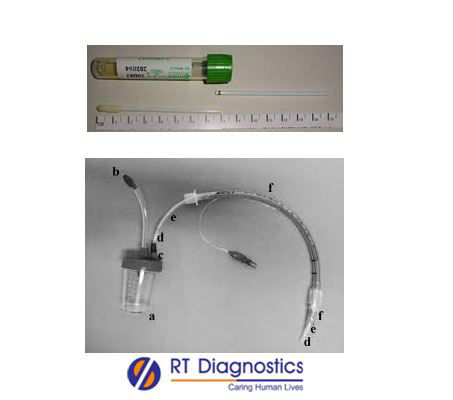Culture & Sensitivity Tracheal:
Why Culture and Sensitivity – Tracheal Test?
CLINICAL INFORMATION
Infections of the respiratory tract like the common cold usually begin with an upper respiratory infection. When symptoms develop with high fever, deep severe cough, difficulty breathing, wheezing, nasal flaring, cyanosis the patients present with stridor and high pitched sound etc due to partial airway obstruction. In some cases, this condition precedes lower respiratory tract infections too leading to further complications. This tracheal test identifies tracheal or tracheobronchial colonization of pathogenic microbes that causes harmful respiratory infections from tracheal aspirates. For this purpose, a sterile catheter – known as Lukens trap is attached and the aspirate is collected by suction. Other alternative methods of executing tracheal aspirate collection methods include a collection of broncho-alveolar lavage (BAL) and also using a protected bronchial brush (PBB). Nasopharyngeal aspirates or nasal wash specimens are the specimens of choice for the detection of respiratory viruses. Culture is a laboratory procedure where a tracheal aspirate fluid sample specimen is placed or inoculated on a growth medium (agar or broth) to induce the proliferation of potentially infectious agents (eg. Bacteria, viruses, fungi etc). When chronic untreated condition prevails it can lead to life-threatening complications such as trachaitis (due to Streptococci pneumonia, Hemophilic influenza, Moraxella catarralis etc), toxic shock syndrome (caused by S.aureus), organ failure, eventually leading to death. Culture and Sensitivity test helps to detect underlying pathologies for the presence of infections (bacteria, virus or fungi etc) or its associated diseases/prevailing conditions (presenting complaints), inflammation.The main objective of performing this test is to check for the presence of the pathogenic organism and its growth in the given suspected sample specimen leading to conditions such as viremia, bacteraemia etc. Hence this test helps to detect for the presence of any systemic infection eg. septicemia that can lead to sepsis (a life-threatening complication). Thus sputum culture and sensitivity test detect the presence of pathogenic bacteria in those who have bacterial pneumonia or a lower respiratory tract infection. Moreover, Anti-microbial sensitivity tests (also known as susceptibility testing) are also performed in addition, for appropriate antibiotic treatment & for better prognosis. Hence tracheal culture test uses this mucus sample specimen to check for any growth of infectious microbes eg. Tuberculosis (Acid-fast bacilli i.e Mycobacterium tuberculi) or serious infection of the airways or the lungs such as pneumonia, bronchitis, cystic fibrosis etc. Some of the symptoms include cough which produces a lot of sputum, breathing difficulties, fever, chills, shortness of breath, chest pain, fatigue, confusion etc. Other tests include blood tests, X-rays (to check for swelling or inflammation), endoscopy (endo-tracheal tube), ESR, CRP, CBC, X-ray studies, ultrasound, CT Scan, MRI etc.

General Instructions:
Sample Requirement: Specimen – Tracheal sample. Test Preparation: None.
NOTE - Sample for specimen collections may vary based on the patient’s condition/cases according to the patient’s presenting complaints/signs or symptoms:
SPECIMEN REQUIREMENT (Special or Rare Cases) - As instructed and guided by Physician / Clinician / Pathologist / as per Laboratory’s requirements, according to procedures and protocols.
Sample Requirement: Tracheal Sample
Test Preparation: None
This Multi-Specialty Clinical Referral Laboratory RT DIAGNOSTICS provides precise and accurate tests with an extensive range of testing services to the medical centres to help in the diagnosis and identification of pathology in the test specimens for infectious diseases and also to evaluate the function of organ systems of the patient. It prevents further complications and helps to stabilize and restore health to near normalcy at the earliest without delay.



